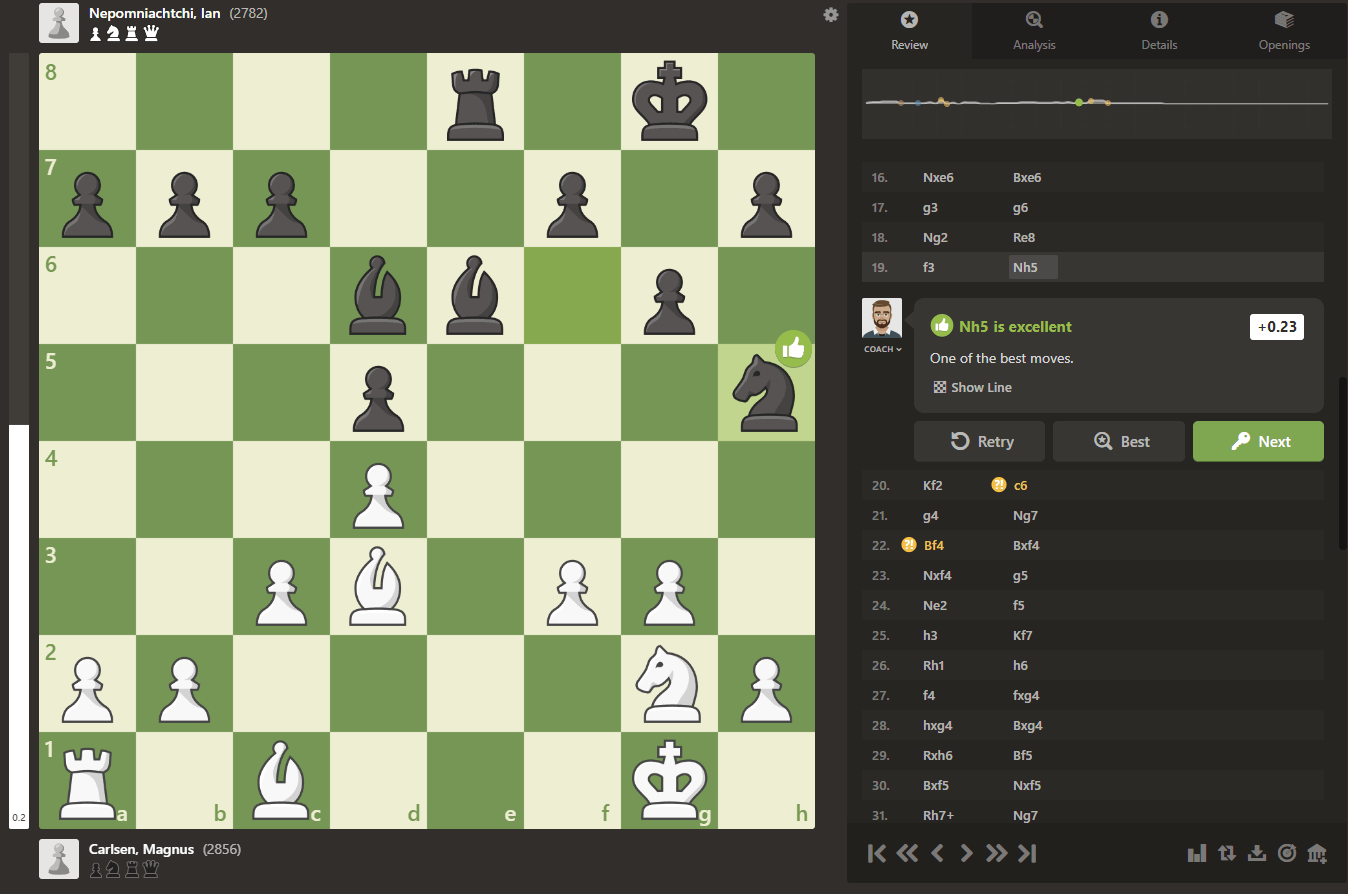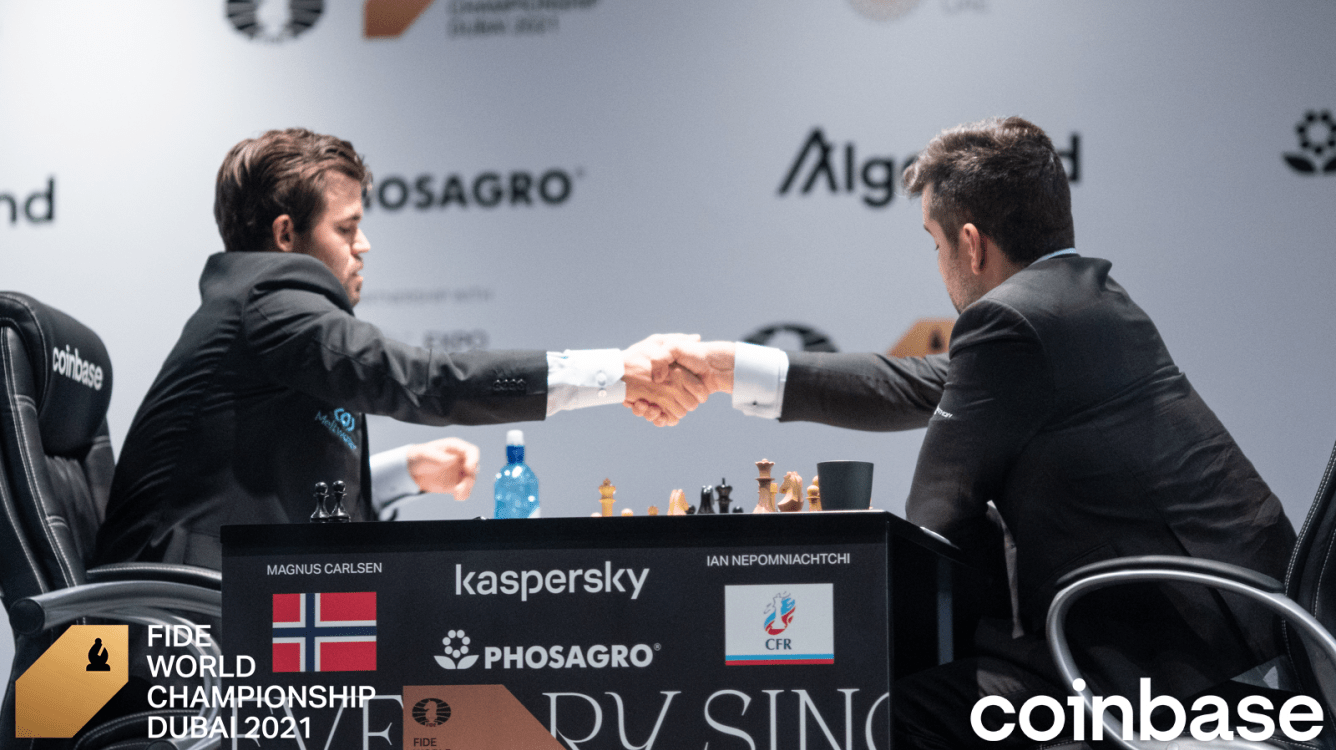
Carlsen One Win From Victory After Drawing FIDE World Chess Championship Game 10
With what was the quickest draw in the match so far, GM Magnus Carlsen consolidated his three-point lead in the 2021 FIDE World Chess Championship on Wednesday. After a bit more than two hours, the world champion split the point with challenger GM Ian Nepomniachtchi, who now cannot afford a loss anymore in the remainder. Game 11 is scheduled for Friday at 16:30 Dubai time (13:30 CET, 4:30 a.m. Pacific).
It ain't over till it's over, but it looks like we're getting close. After a quick draw in another Petroff, Carlsen is just a point away from winning his fifth title match. The general consensus is that Nepomniachtchi has to go all out on Friday when he plays with the white pieces, and if things go wrong, it could end up being the last game of this championship.
It's definitely what Nepo is planning to do: "Of course, I'll try to push with white in the next game," he told Chess.com's FM Mike Klein in their short interview right after the game.
So why didn't he try today? "It was necessary first and foremost to play a normal game without blunders," Nepo said. "The main plan was not to do something stupid today."
The main plan was not to do something stupid today.
—Ian Nepomniachtchi
Nepomniachtchi's choice to play 1...e5 was a slight surprise as many pundits felt that today's game already called for stronger measures such as the Sicilian. As GM Fabiano Caruana put it, "White has a million ways to force a draw against 1.e4 e5."
However, already on the second move, it became clear that the challenger didn't mind a draw either. He chose the Petroff again, something Carlsen hadn't expected.
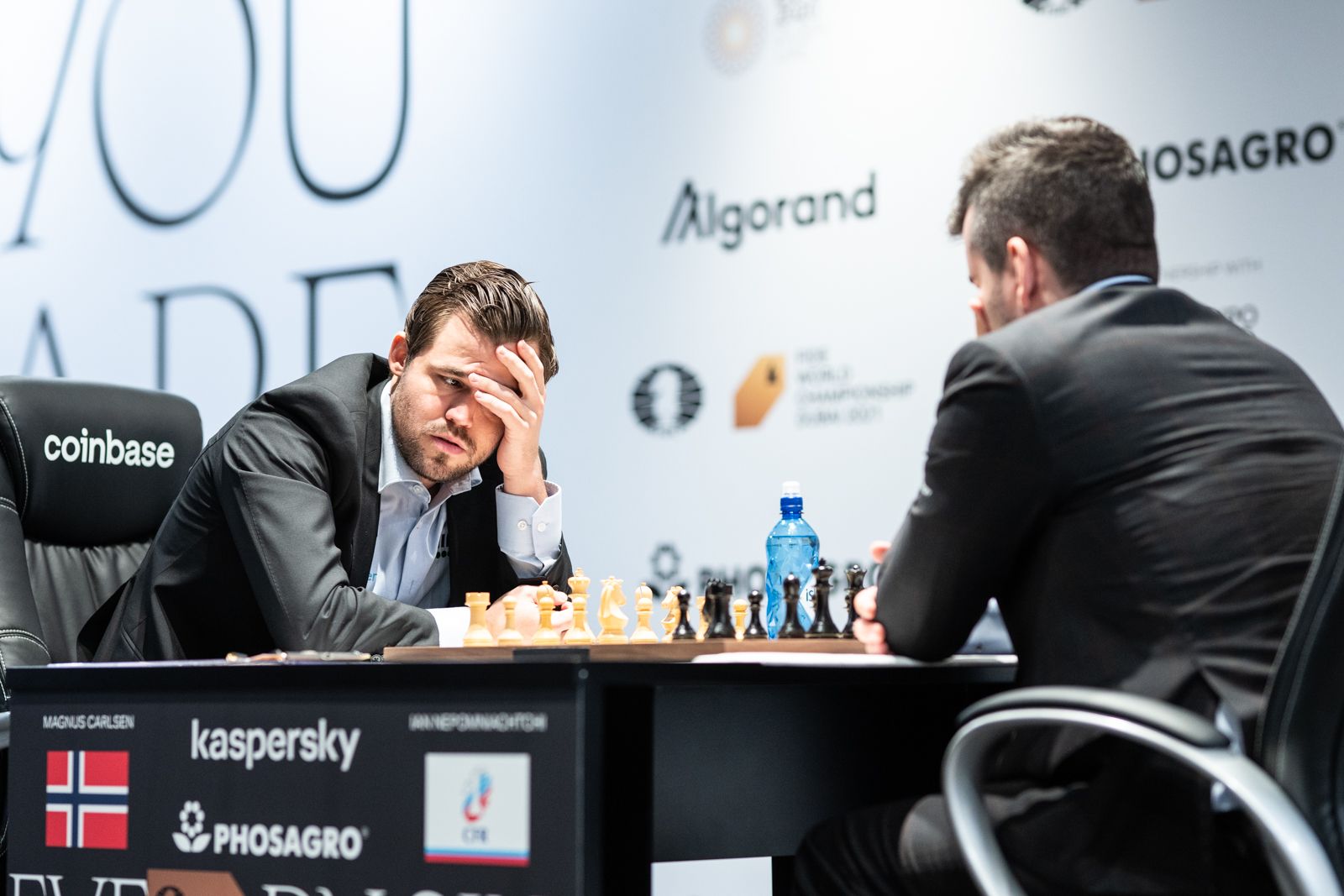
"Frankly, I hadn't thought about him playing the Petroff today at all. I was praying for various sharp openings that he could play, and the thought was that if he goes 1...e5 then I'll see. I didn't think making a draw against the Petroff would be a major issue."
I didn't think making a draw against the Petroff would be a major issue.
—Magnus Carlsen
So, why not something sharper as Black? "The problem is, basically, playing as Black you don't have such a big choice," argued Nepomniachtchi. "Especially when it's classical, even if you play a so-called sharp opening like the Sicilian, if White wants to shut it down White surely will shut it down."
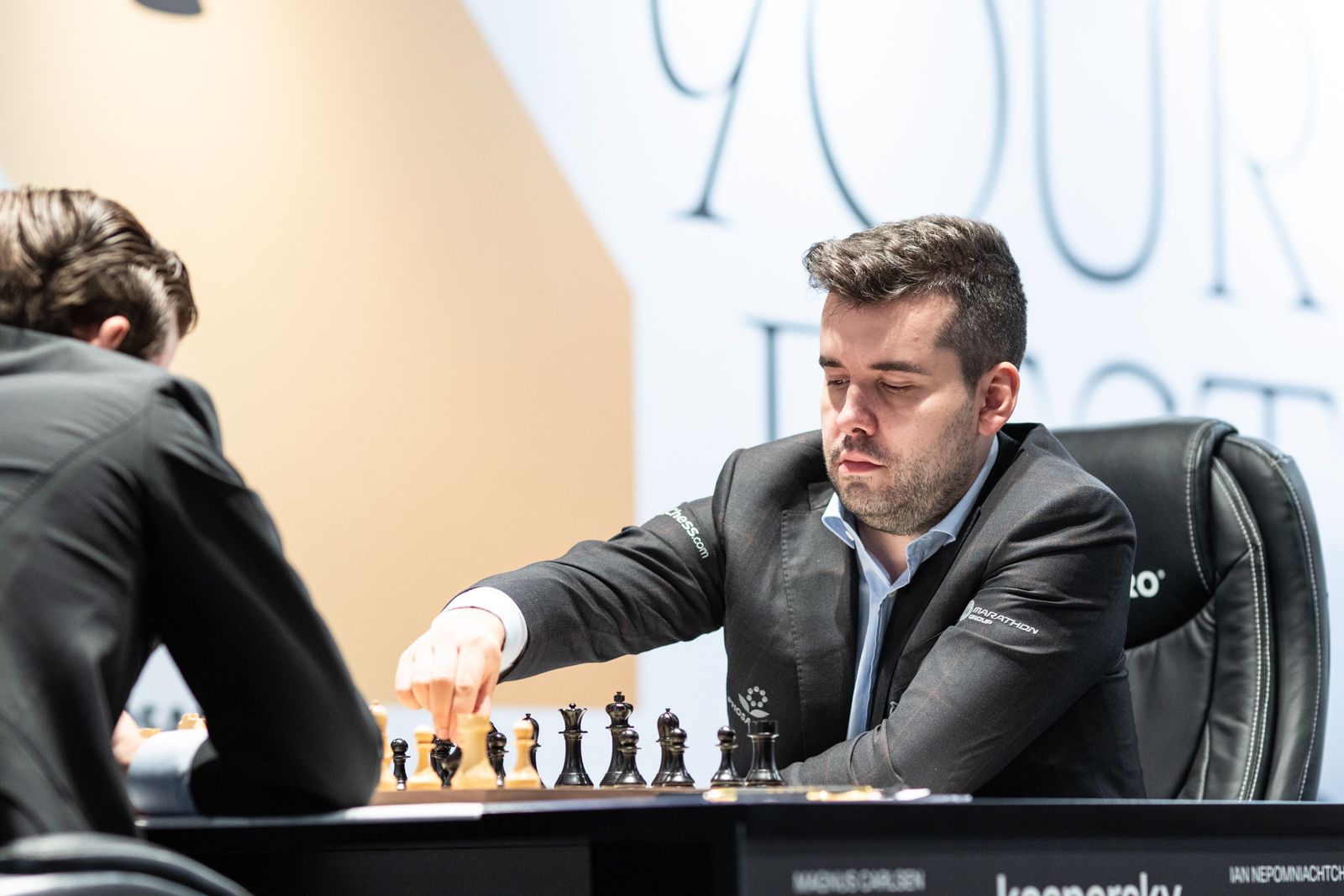
In the Chess.com broadcast, GM Robert Hess quickly pointed out that going for a drawish line with a quick Qe2+ made a lot of sense for Carlsen, given the match situation, and that's what happened. After 4.Nd3, a move Carlsen had also played against Caruana in the previous world championship (an 80-move draw), there followed 4...Nxe4 5.Qe2+ Qe7 and soon the queens left the board.
Position after 5...Qe7.
This was exactly what Carlsen wanted on this particular day. His motivation to go for the 4.Nd3 line? "Mainly the prospects of getting the queens off very soon and getting a dry position," he said.
He might be known for almost always playing for a win, but even for Carlsen, there are situations where he just wants a draw with the white pieces. "There was some discussion in my team," he revealed at the press conference, "but I was definitely not pushing for something, for a different approach, let's say."
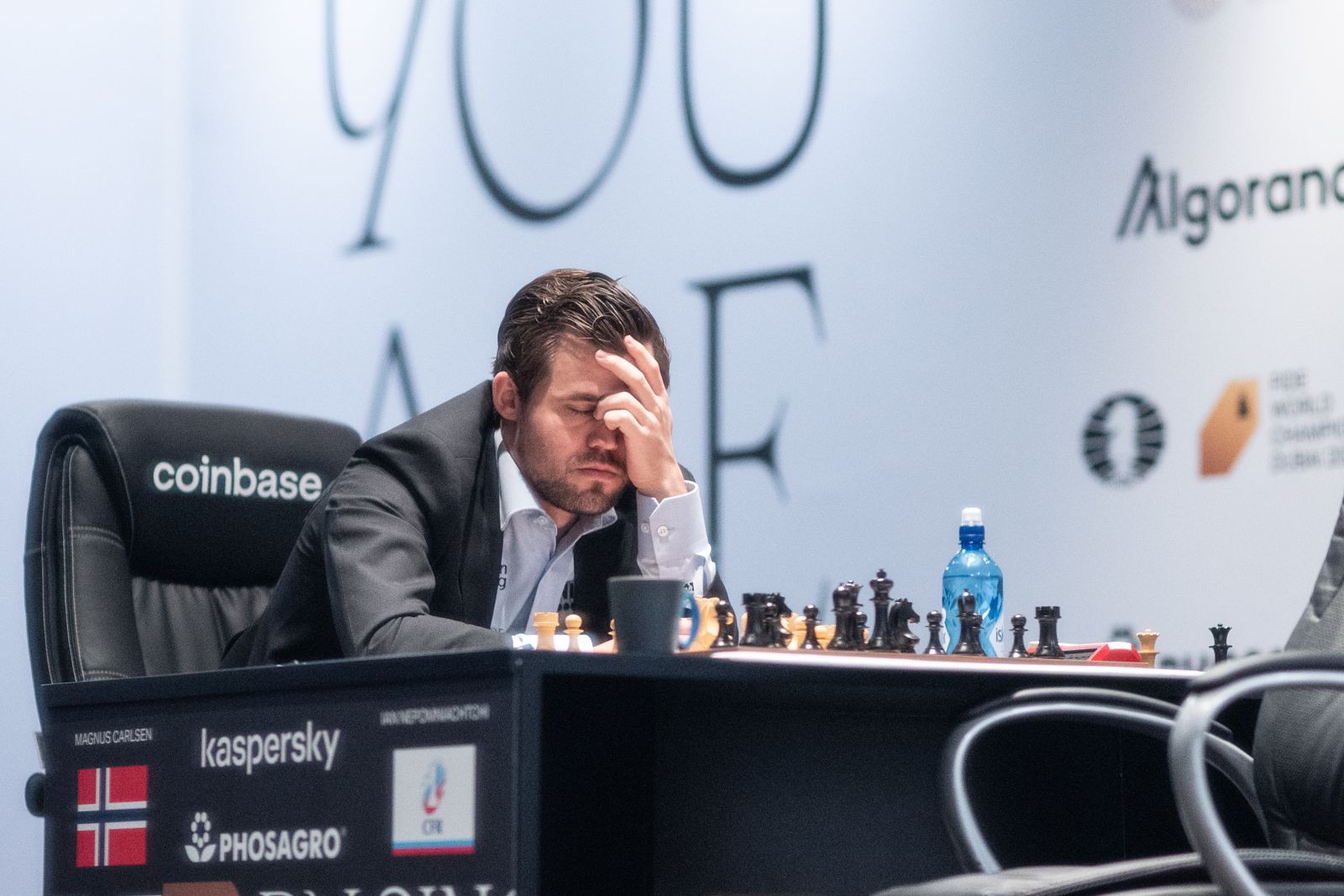
On move six, Nepomniachtchi deviated from that Carlsen-Caruana game by immediately putting his king's knight back to f6 (instead of developing his queen's knight), which seemed like the safest choice. When he played ...Nc6 one move later, it turned out to be the theoretical novelty and Carlsen spent 19 minutes on his eighth move.
Position after 7...Nc6N.
Here, the Chess.com commentators were hoping for 8.Be3, which avoids the queen trade after all and which could have led to rather sharp positions, but Carlsen went for the endgame anyway—or queenless middlegame, if you will.
Nepomniachtchi called it a "huge moment" in the game, noting that 8.Be3 "would spice things up a little."
"7...Nc6 was a bit of a surprising move order to me," said Carlsen afterward. "8.Be3 is a move there and surely the critical one but I was just not in the mood. I think the match situation sort of explains that."
The world champion was mildly optimistic when he played 17.g3 when he was still hoping for a chance to play one of his typical, long squeezes.
As the players maneuvered their pieces to their optimal squares, it turned out that Nepomniachtchi was fully ready to play this type of position. He continued very accurately, especially with his 19th move, and neutralized any slight edge White may still have had.
While doing so, the challenger also stayed much more at the board than he had done in the previous games. When asked about this, he remarked: "I guess the chair was more comfortable than the sofa," before adding: "In today's game, it was more or less obvious that it won't last too long. It wasn't a big difference where to sit."
Our Game of the Day annotator GM Sam Shankland summed up the game as follows: "Game 10 was only interesting in that it showed some of the players' priorities and choices—the gameplay itself was an absolute snoozefest. Magnus predictably went for 1.e4, which is certainly the best move to play in a situation where a draw is a very welcome result."
Match score
| Fed | Name | Rtg | 01 | 02 | 03 | 04 | 05 | 06 | 07 | 08 | 09 | 10 | 11 | 12 | 13 | 14 | Score |
| Magnus Carlsen | 2855 | ½ | ½ | ½ | ½ | ½ | 1 | ½ | 1 | 1 | ½ | . | . | . | . | 6½ | |
| Ian Nepomniachtchi | 2782 | ½ | ½ | ½ | ½ | ½ | 0 | ½ | 0 | 0 | ½ | . | . | . | . | 3½ |
Carlsen admitted that he was simply happy to add half a point to his score today, saying: "At this point, there are so few games to go that any draw is an excellent result. I mean, I very much assume he's gonna try and win, especially with the white pieces. But sure, any half point that I can get is great, and I think that's pretty obvious."
For the first time, WFM and chess streamer Anna Cramling asked a question at the press conference and it seems Carlsen liked it. The question was: If you could only play 1.e4 or 1.d4 for the rest of your life, which of the two would you choose and why? The world champion's reply:
"That's a little bit different from other questions—thank you! I would probably go for 1.e4. It seems there is a little more variety there in both closed and open games, but otherwise, I'm thinking that it's probably enough theory that we have already and it's difficult enough to get an opening advantage, so to actually be restricted to only one move would be a bit of a nightmare."
Nepomniachtchi: "Well, I guess about a hundred years ago, Rauzer said that White just wins after 1.e4, so quite something changed since then! But yeah, in general, overall, it feels like 1.e4 is nowadays more forcing but at the same time the more fun, so let it be 1.e4."
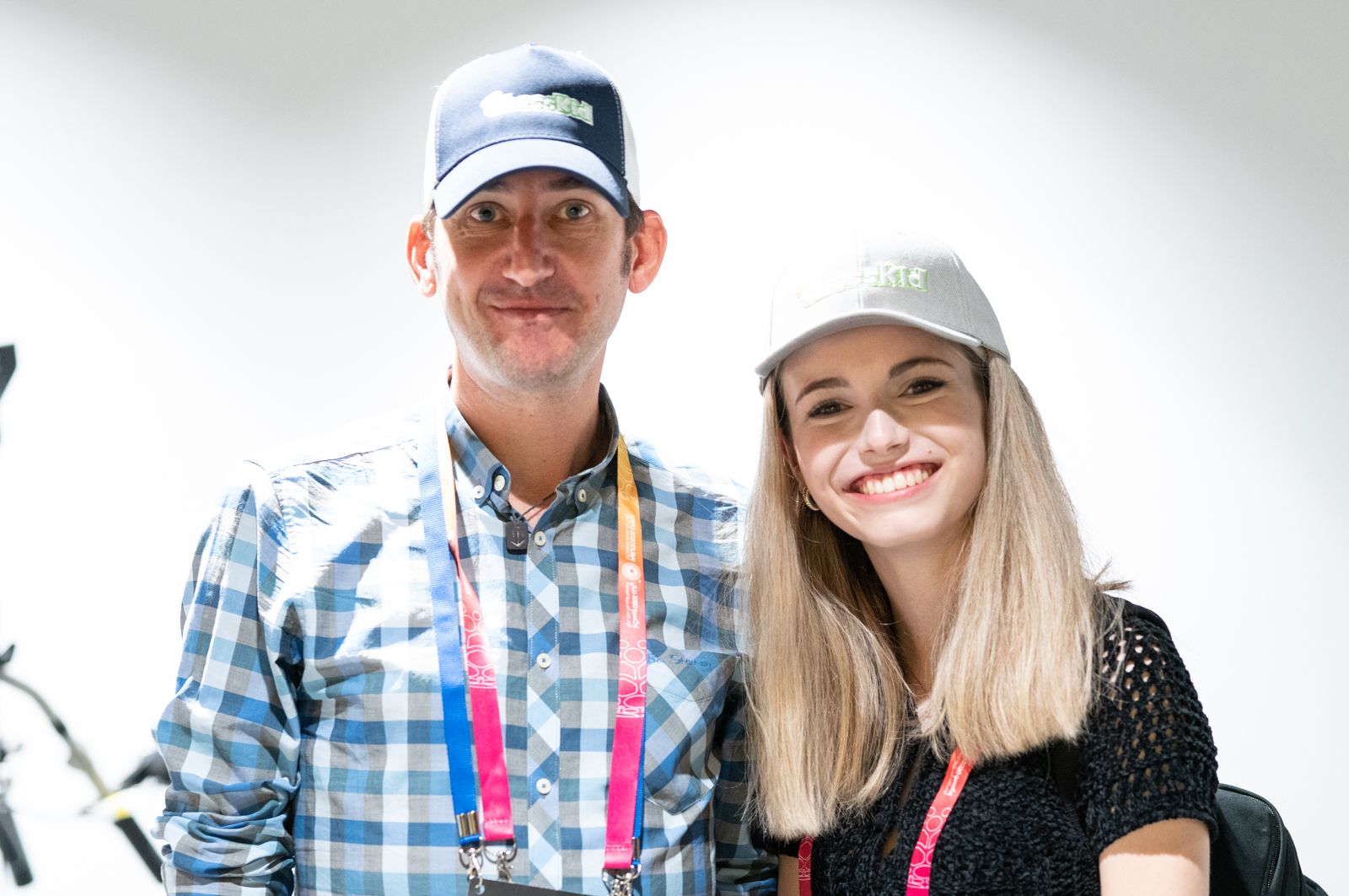
During the game, FIDE brought the news that the FIDE World Rapid & Blitz Championships will not be held in Kazakhstan in December because of new COVID-19 restrictions in the country. At the moment, the International Chess Federation is examining alternative host cities and plans to publish an update towards the end of the week.
Nepomniachtchi noted that this is "the reality we live in," while pointing out that he hadn't made a decision yet whether he was going to play. Carlsen hopes it will still be held and plans to play. Answering the question of how prestigious the rapid and blitz titles are, he said:
"They're comparable in the sense that the classical title is only contested every two years and the rapid and blitz are, at least supposed to be, every year. I think that answers the question. Apart from that, I'm really really happy for the effort that has been made to organize a rapid and blitz championship over the last few years. It certainly added something special to the calendar and it's obviously very prestigious as well."

While the last two classical world championship matches actually saw rapid chess, with Carlsen making the difference in the playoff, this scenario is far less likely this time around. Going into another rest day, Nepomniachtchi has one and a half days to rest and prepare for a game where only one result works for him. If he manages to win, he'll need to repeat that twice, against the best player in the world. Against all odds.
Chess.com’s coverage is brought to you by Coinbase. Whether you’re looking to make your first crypto purchase or you’re an experienced trader, Coinbase has you covered. Earn crypto by learning about crypto with Coinbase Earn, power up your trading with Coinbase’s advanced features, get exclusive rewards when you spend with Coinbase Card, and much more. Learn more at Coinbase.com/Chess.
Previous coverage:
- Carlsen On Verge Of Retaining Title As Nepo Blunders Piece
- Carlsen Wins Game 8 As Nepo Falters In FIDE World Chess Championship
- Confident Carlsen Equalizes Easily In FIDE World Championship Game 7
- Carlsen Wins Game 6, Longest World Championship Game Of All Time
- Carlsen Defends Passively To Draw Game 5 FIDE World Chess Championship
- Nepo Holds Carlsen With Petroff In Game 4 FIDE World Chess Championship
- FIDE World Chess Championship Game 3: Magnus Bulletproof With Black
- FIDE World Chess Championship Game 2: Adventurous Carlsen Scrambles For Draw
- FIDE World Chess Championship Game 1: Nepo Impresses Under Pressure
- FIDE World Chess Championship 2021: Carlsen-Nepomniachtchi
- Know The Champion: Magnus Carlsen
- Know The Challenger: Ian Nepomniachtchi
- All The World Chess Champions

